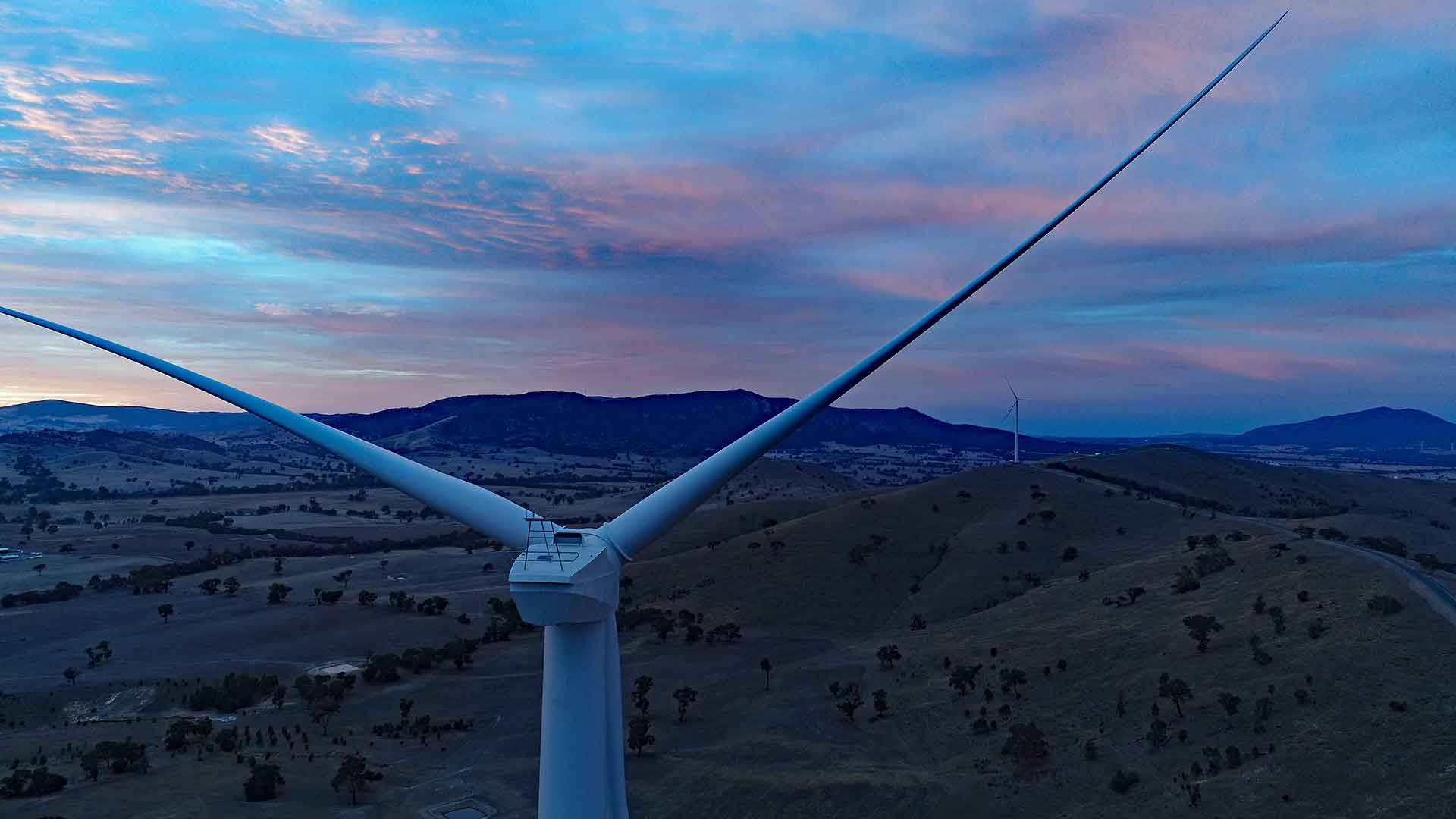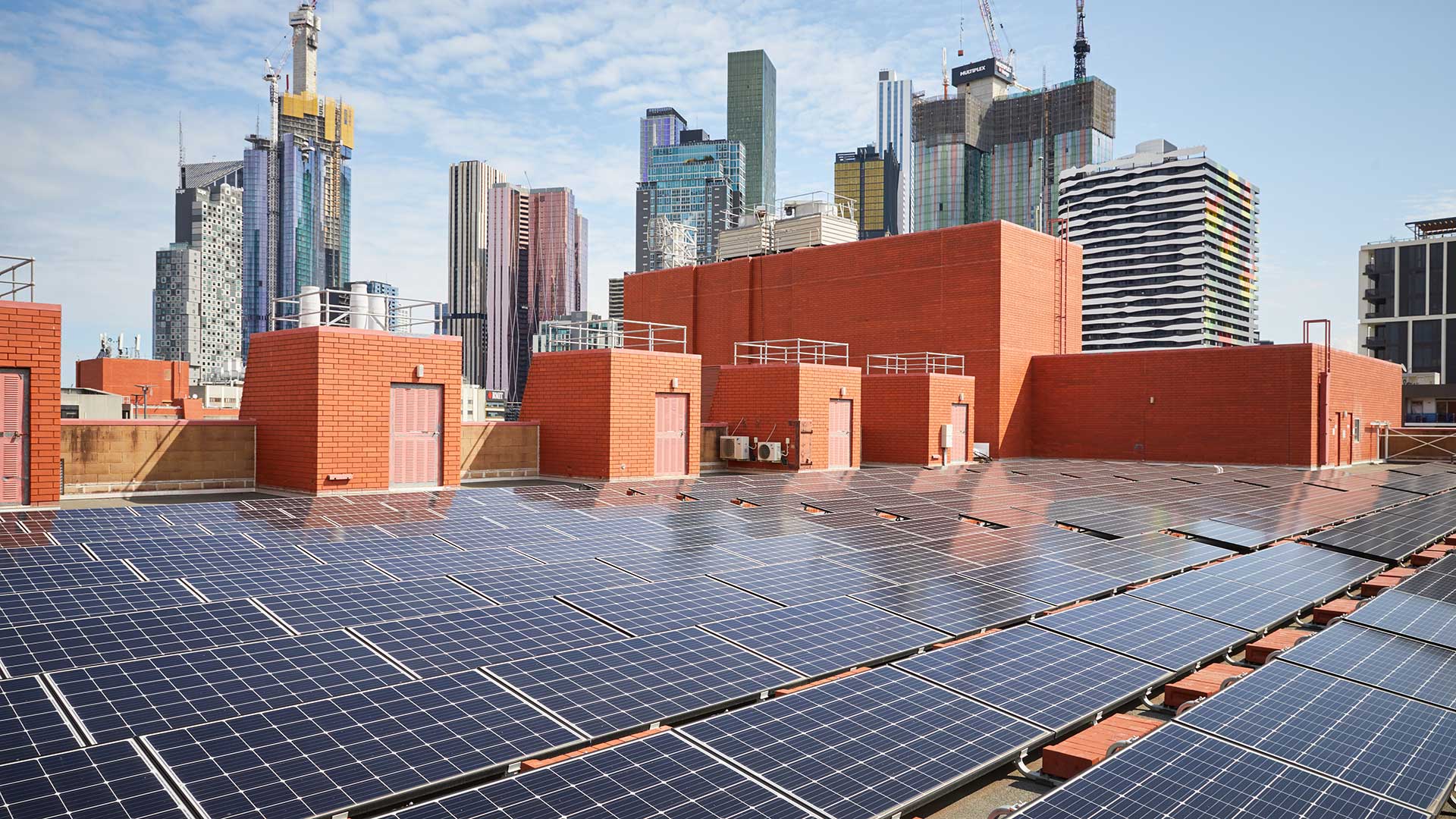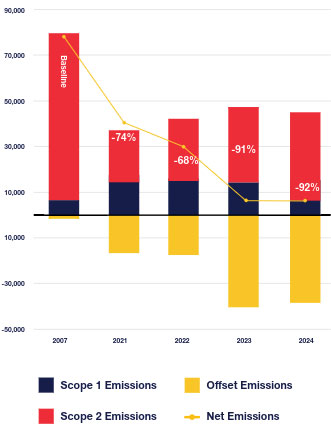Carbon and climate

RMIT is proud that since 1 January 2023, all our onshore grid electricity is sourced from two wind farm projects in Regional Victoria, through the Melbourne Renewable Energy Projects (MREP).
The RMIT Carbon Management Plan (PDF 7 MB) provides strategic guidance for the university to manage its greenhouse gas emissions profile and outlines scenarios for the future. The Plan serves as a commitment by RMIT University to accurately measure, report and manage the emissions profile of the University.
RMIT follows the carbon management hierarchy of eliminating emissions from operations in the first instance. Reducing onsite emissions requires more perseverance and strategic capital investment in comparison to offsetting, RMIT considers this to be a more practical approach to emissions management.
RMIT has demonstrated sustainability leadership through our role in two large-scale renewable energy purchasing groups with our city partners - the Melbourne Renewable Energy Projects 1 & 2. These two renewable energy supply agreements contribute to the Sustainable Development Goals of affordable and clean energy and climate action.
RMIT joined the City of Melbourne in forming the first Melbourne Renewable Energy Project (MREP 1) in 2017. It was the first time in Australia that a group of local governments, cultural institutions, universities and corporations collectively purchased renewable energy from a newly built facility.
 Image credit: Pacific Hydro
Image credit: Pacific Hydro
The fourteen members of that buying group combined their purchasing power to support the construction of a 39-turbine, 80 MW wind farm at Crowlands, near Ararat.
MREP 1 members commit to purchasing electricity from the wind farm for ten years under a power purchase agreement. The Crowlands wind farm generates more than the purchasing group's needs, bringing additional renewable energy into the market. It also provides long-term price certainty, enabling customers to mitigate the risk of increased energy costs in a volatile market.
RMIT University led a second group of Melbourne universities and businesses to secure another long-term power purchase agreement. RMIT and six partners used their combined purchasing power to secure wind energy through MREP 2.
Most of the wind power is produced at the Yaloak South Wind Farm near Ballan, with the remaining energy coming from other wind farm projects in regional Victoria.
The MREP 2 deal provides 110 GWh of electricity to the group per year, the equivalent to providing renewable energy to power more than 22,000 Australian households every year. It will reduce greenhouse gas pollution by 123,000 tonnes a year, which is comparable to taking nearly 28,000 cars off the road.
For more information, visit Melbourne Renewable Energy Project.
RMIT is strongly committed to transforming its own built environment to create sustainable and resilient cities. To achieve this, RMIT is focusing on energy efficiency and emissions reduction in all capital projects. All projects must demonstrate a contribution to the goal of becoming carbon neutral and design elements are guided by sustainable design principles within the RMIT Design Standards.
For more information, visit Sustainable Buildings.
RMIT has installed solar PV across University rooftops, maximising the use of on-site renewable energy generation wherever possible. The university continues to advance the rollout of solar through our capital development program. RMIT’s existing 596 kW solar PV portfolio has over 2,500 panels, including 400 test panels integrated into the B100 Design Hub façade.
 Solar PV on University rooftop
Solar PV on University rooftop
The project, completed in 2024, is the first of the complex projects to remove natural gas assets, in a phased program to 2030. RMIT has committed to no new natural gas assets (excluding those required in research labs), which is enforced through our Design Standards.
In 2017, RMIT completed a $128 million program to reduce energy and water use, significantly lowering greenhouse gas emissions associated with campus operations. The program of works included on-site high-voltage networks, high-efficiency boiler and chiller upgrades, over 40,000 LED light fittings, water savings fittings and fixtures, rainwater harvesting and upgrades to building management systems.
The Sustainable Urban Precincts Program was the largest energy performance contract in the Southern Hemisphere. Delivering over 30,000 tonnes of emissions savings every year.
For more information, visit our SUPP page.
Climate change and its impacts are posing a significant risk for our society today. In Australia, extreme weather events such as droughts, bushfires, cyclones and floods are expected to become more frequent and more severe. Universities such as RMIT, are important public organisations that have significant elements at risk from climate-related impacts; including buildings, infrastructure assets, our people and the wider community.
It is therefore important that key climate risks are identified, and the necessary adaptation options implemented to increase resilience to future climate shocks and stresses.
The Climate Change Adaptation Plan (PDF 1.7 MB) is to ensure that our community and infrastructure can continue to operate in a safe and sustainable manner in any climate or extreme weather event scenario.
RMIT achieved a 92% reduction in Scope 1 and 2 emissions in 2024, based on a 2007 baseline, showing a slight decrease from 2023 totals. This significant reduction is mainly due to reduced gas usage following the shutdown of on-site gas engines in late 2022. From 1 January 2023, all onshore grid electricity was sourced from renewable energy. The Melbourne Renewable Energy Projects 1 & 2 supplied 50,107MWh of renewable electricity to RMIT in 2024. Under the Australian operational emissions profile, RMIT accounts for all energy and emissions within the building portfolio, using emissions factors in accordance with the National Greenhouse and Energy Reporting Act 2007.
All targets are set against a 2007 baseline, with initial emissions at 78,048 tCO2-e. A detailed global emissions profile will be discussed in later sections.
 Graph showing RMIT emissions reduction from the baseline year of 2007. Greenhouse gas emissions reduced by 74% in 2021, 68% in 2022 (showing the return to campus), 91% in 2023 and 92% by the end of 2024.
Graph showing RMIT emissions reduction from the baseline year of 2007. Greenhouse gas emissions reduced by 74% in 2021, 68% in 2022 (showing the return to campus), 91% in 2023 and 92% by the end of 2024.
For more information on our annual metrics, visit Sustainability Annual Report.


RMIT University acknowledges the people of the Woi wurrung and Boon wurrung language groups of the eastern Kulin Nation on whose unceded lands we conduct the business of the University. RMIT University respectfully acknowledges their Ancestors and Elders, past and present. RMIT also acknowledges the Traditional Custodians and their Ancestors of the lands and waters across Australia where we conduct our business - Artwork 'Sentient' by Hollie Johnson, Gunaikurnai and Monero Ngarigo.
Learn more about our commitment to Indigenous cultures